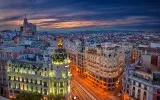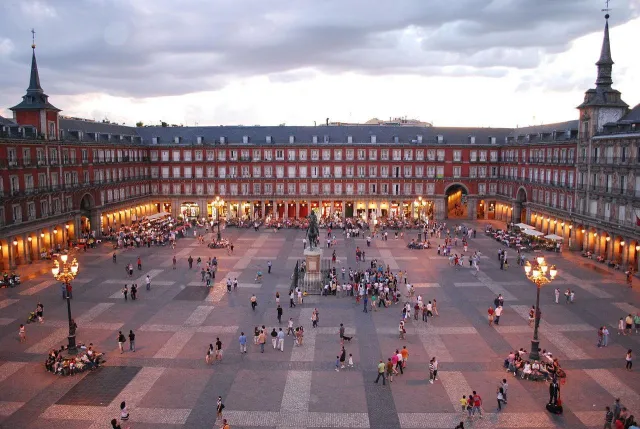Barcelona travel - Spain
Home to soccer enthusiasts, architecture geek...
By Susan Giles2404

0

Located in the heart of the Iberian peninsula, Madrid is a city of a thousand wonders. The Spanish capital’s unique charm and cultural patrimony continually attract millions of visitors every year, making it one of the top destinations for international travelers.
With plenty of sunshine, illustrious landmarks, urban facilities, shopping venues, eateries, and bars, Madrid is a superb place for a memorable and enriching vacation… or even a permanent move!
In this dedicated guide, we’ll survey everything this iconic city has to offer, and provide you with valuable insights if you ever plan a trip to this lively, warm, and picturesque region.
City Facts
Madrid is the administrative capital of Spain, which it has been since the 17th century, and the country’s largest city. The official language is Castilian Spanish. There, you won’t find as many English speakers as in Barcelona. Like most European neighbors, the country uses the Euro as its national currency.
Madrid has been acclaimed time and again as one of the most pleasant touristic destinations across all of Europe. From monuments and museums to parks and entertainment venues, Madrid is a place for the urban explorer-at-heart.
The city fosters great cosmopolitan vibes and a genuine sense of warmth that’s bound to make everyone feel at home. Besides, Madrileños and Madrileñas are known for their friendly, helpful, and passionate characters.
Climate
Despite its location at the country’s center, Madrid enjoys a superb Mediterranean-style climate all year long. In fact, it may be the sunniest capital in Europe. Summers (from June to September) are typically quite hot and humid during daytime, with temperatures often exceeding 30°C (86°F).
By contrast, winters (December through March) are characterized by dry, mild, sometimes rainy days and cool nighttime temperatures. They can reach 6°C (420°F) in January, the coldest month of the year. However, Madrid isn’t known as a particularly snowy city.
When to Visit
Like most sunny destinations, Madrid teems with visitors during summer months. Not only can the weather get excessively hot, but navigating through the crowds of tourists can quickly get overwhelming. As such, the ideal time of year to visit the Spanish capital is during either the spring (late March through early June) or the fall (September through November). This is a guarantee to enjoy the most pleasant weather and best prices, roam around freely, and avoid the packed peak seasons.
Transportation and Safety
Madrid happens to have an excellent subway system which, aside from covering the entire city, is air-conditioned, clean, and one of the most affordable means of urban transportation. The bus network is just as developed and convenient. An even safer alternative would be white taxis, which abound around the capital but are slightly more expensive in terms of fares.
There are always Ubers, too, along with other private car companies to take you around. In regard to safety, it’s advised to keep belongings close by and always watch out for pickpockets who often strike in public transport, touristic spots, and other crowded avenues.
Accomodations
As any city, choosing the right accommodation is key for a nice, comfortable, and memorable trip. Fortunately, Madrid isn’t short of offerings for places to stay. Budget travelers will want to look into hostels, starting at around $20-$25 per night. An Aibnb could be an even more economical choice depending on the length of stay and choice of neighborhood.
Those with larger envelopes won’t have any trouble finding 4 or 5 stars hotels with luxury amenities and superb views over the city. In any case, be sure to book your accommodation at least a few months in advance; as one of the most popular European destinations, hotel rooms fill up quickly throughout the year.

Must-Visits
With its Habsburgian architectural heritage, the Spanish capital abounds with mesmerizing places that deserve a spot of choice on any traveler’s itinerary. Among them is the majestic Plaza Mayor, a popular gathering venue for both locals and tourists to walk around and enjoy the outdoors, sit at a café, eap, shop, and take photos.
A few blocks away lies another famous square, the Puerta del Sol, the city’s geographical center and one of its busiest spots. There, we can find the iconic clock tower and statue of King Carlos III. Also, the Palacio Real de Madrid (Royal Palace) is the official residence of Spanish monarchs and a popular attraction of the city. Built in the mid-18th century, it’s now open to the public and is a mandatory stop on Madrid tours.
Another mention goes to the splendid El Retiro Park, a 350-acre park located in the heart of the capital, boasting various monuments, sculptures, galleries, and even a lake.
Cultural Attractions
History and art enthusiasts will find Madrid to be a genuine haven with its illustrious and countless museums, galleries, cultural centers, and other artistic venues. Situated in the so-called Golden Triangle of Art, along the Paseo del Prado, lie three of Spain’s most iconic national museums.
There’s the Prado Museum, which features pre-20th century art; the Reina Sofía Museum dedicated to modern 20th century art; and the Thyssen-Bornemisza Museum that features contemporary art collections.
Other art venues that are worth the detour include the newly renovated National Archeological Museum, the Naval Museum, as well as the CaixaForum cultural center that opened its doors to the public in 2008.
Shopping
Madrid is a fantastic place for a shopping spree. The Salamanca District, located in the city center, abounds with various stores, brand-name shops, and designer boutiques that will satisfy any shopaholic. Known as the “Spanish Broadway,” Calle Gran Vía harbors a variety of shops, cinemas, and eateries, and is home to El Cortes Inglés, a world-class department store.
Further south is Calle de Preciados, a pedestrian street and one of the liveliest in Madrid. It shelters lots of fashion and convenience stores, tapas bars, and restaurants. North of the city center lies Calle de Serrano, a ritzy shopper’s haven with international luxury brands and fine dining restaurants.
Those who prefer bohemian vibes should head to Calle de Fuencarral, a modern shopping avenue that is home to alternative brands, Asian boutiques, and quaint cafés. An honorable mention must go to El Rastro, the most popular flea market in the capital, held weekly on Plaza de Cascorro.
Food Scene
The Spanish notoriously love to eat. What strikes in Madrid is the number of eateries, restaurants, tapas bars, and food joints where one can grab a bite and sample the colorful local cuisine. Found in the upscale Chamberí neighborhood, Calle Ponzano is a culinary paradise filled with trendy restaurants and contemporary eateries.
Not far from the Puerta del Sol lies the Anton Martin neighborhood, is a formidable place to taste traditional wines and tapas (especially around Calle Santa Isabel). Another popular spot for foodies include the La Latina neighborhood and its vibrant Calle Cava Baja with tapas bars and relaxed vibes. Wherever you turn, you’ll always find a great place to eat and experience the flavors and innovations of Spanish cuisine.
At the end of the day, few cities in Europe manage to capture such a lively, open-minded, and cosmopolitan atmosphere as much as Madrid. Whether it’s through the friendly people, the weather, monuments and museums, or the delectable food scene, anyone who visits the Spanish capital is bound to have an astonishingly great time and make life-long memories!
Updated 4 years ago